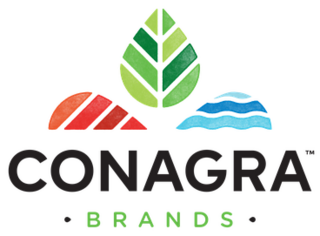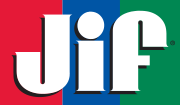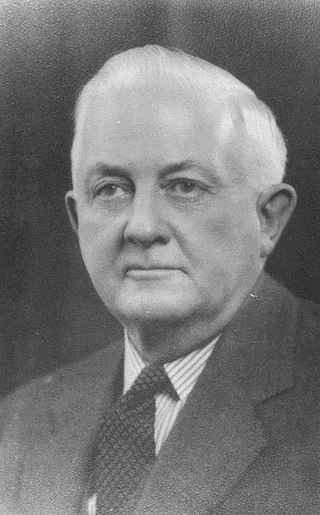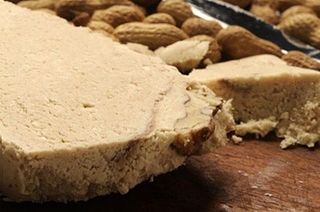Related Research Articles

Peanut butter is a food paste or spread made from ground, dry-roasted peanuts. It commonly contains additional ingredients that modify the taste or texture, such as salt, sweeteners, or emulsifiers. Consumed in many countries, it is the most commonly used of the nut butters, a group that also includes cashew butter and almond butter.

Planters Nut & Chocolate Company is an American snack food company now owned by Hormel Foods. Planters is best known for its processed nuts and for the Mr. Peanut icon that symbolizes them. Mr. Peanut was created by grade schooler Antonio Gentile for a 1916 contest to design the company's brand icon. The design was modified by a commercial artist and has continued to change over the years.

The J.M. Smucker Company, also known as Smuckers, is an American manufacturer of food and beverage products. Headquartered in Orrville, Ohio, the company was founded in 1897 as a maker of apple butter. J.M. Smucker currently has three major business units: consumer foods, pet foods, and coffee. Its flagship brand, Smucker's, produces fruit preserves, peanut butter, syrups, frozen crustless sandwiches, and ice cream toppings.

Conagra Brands, Inc. is an American consumer packaged goods holding company headquartered in Chicago, Illinois. Conagra makes and sells products under various brand names that are available in supermarkets, restaurants, and food service establishments. Based on its 2021 revenue, the company ranked 331st on the 2022 Fortune 500.

Greenwood is a neighborhood in north central Seattle, Washington, United States. The intersection of Greenwood Avenue North and North 85th Street is the commercial center. Greenwood is known for its numerous bars, restaurants, coffee houses, theatres and specialty stores. Greenwood's main thoroughfares are Greenwood Avenue North and N. 85th streets.

Jif is an American brand of peanut butter made by The J.M. Smucker Company, which purchased the brand from Procter & Gamble in 2001.

Skippy is an American brand of peanut butter manufactured in the United States and China. First sold in 1932, Skippy is currently manufactured by Hormel Foods, which bought the brand from Unilever in 2013. It is the best-selling brand of peanut butter in China and second only to the J.M. Smucker Company's Jif brand worldwide.

Peter Pan is an American brand of peanut butter that is marketed by Post Consumer Brands, part of Post Holdings. Named after the J. M. Barrie character, the product was introduced by Swift & Company through its Derby Foods subsidiary, E.K. Pond Company. It was renamed "Peter Pan" in 1928.

Reese's Peanut Butter Cups are an American candy by the Hershey Company consisting of a peanut butter filling encased in chocolate. They were created on November 15, 1928, by H. B. Reese, a former dairy farmer and shipping foreman for Milton S. Hershey. Reese was let go from his job with Hershey when the Round Barn which he managed was shut down for cost-saving measures. He subsequently decided to start his own candy business. Reese's are a top-selling candy brand worldwide, with $3.1 billion in annual sales.

Harry Burnett Reese was an American inventor and businessman known for creating the number one-selling candy brand in the United States; Reese's Peanut Butter Cups, and founding the H. B. Reese Candy Company. In 2009, he was posthumously inducted into the Candy Hall of Fame.
The Clark Bar is a candy bar consisting of a crispy peanut butter/spun taffy core and coated in milk chocolate. It was introduced in 1917 by David L. Clark and was popular during and after both World Wars. It was the first American "combination" candy bar to achieve nationwide success. Two similar candy bars followed the Clark Bar, the Butterfinger bar (1923) made by the Curtiss Candy Company and the 5th Avenue bar (1936) created by Luden's.

Farley's & Sathers Candy Company was created as an umbrella company to roll up many small companies, brands and products under a common management team. The confectionery business segment is made up of many small companies, often with intertwined relationships and histories.
Squirrel was a Canadian brand of peanut butter, marketed from about 1915 to about 2000.

The National Building is a historic warehouse building in downtown Seattle, Washington, located on the east side of Western Avenue between Spring and Madison Streets in what was historically Seattle's commission district. It is now home to the Seattle Weekly. It is a six-story plus basement brick building that covers the entire half-block. The dark red brick facade is simply decorated with piers capped with small Ionic capitals and a small cornice, which is a reproduction of the original cornice. Kingsley & Anderson of Seattle were the architects.

Mantecol is the brand name of a typical dessert of the cuisine of Argentina, a sort of semi-soft nougat made from peanut butter. It was originally created and marketed in the 1940s by the confectionery company Georgalos, founded by a Greek immigrant, Miguel Georgalos, who took inspiration from a dessert in Greek cuisine, halva.

The Agen Warehouse, also known as the 1201 Western Building is an historic former warehouse building located at 1201 Western Avenue in Seattle, Washington. Originally constructed in 1910 by John B. Agen (1856–1920), widely considered the father of the dairy industry in the Northwest, for his wholesale dairy commission business, it was designed by the partnership of John Graham, Sr. and David J. Myers with later additions designed by Graham alone. After years of industrial use, the building was fully restored to its present appearance in 1986 for offices and retail with the addition of a penthouse and was added to the National Register of Historic Places on January 23, 1998.

Rockwood & Company was a New York City-based chocolatier which operated from 1886 until 1957. It coordinated the industry's first resale price contracts, operated the largest chocolate factory in New York, and was the second largest producer of chocolate in the United States, after the Hershey Company. Founded in the borough of Manhattan, it moved to the Brooklyn neighborhood of Wallabout, gradually expanding its footprint to occupy most of a city block. In 1919, a fire led to a flood of chocolate in the street, attracting a crowd of children. Rockwood & Company sold the factory to the Sweets Company of America in 1957, who used it to produce Tootsie Rolls until it closed in 1967. The Rockwood & Company factory complex was listed on the National Register of Historic Places in 1983, which was later merged into the Wallabout Industrial Historic District. It was converted to luxury apartments in 1996.
The Wisconsin butter fire, also known as the butter flood, great cheese fire, and great butter fire, was a fire and flood of processed meat and dairy that began on May 3, 1991, at a large storage facility in Madison, Wisconsin. The fire continued for eight days; there were no fatalities, but it caused millions of dollars in damages. The incident is known as the biggest commercial fire in Wisconsin state history and the Madison Fire Department's biggest and most expensive challenge.
References
- 1 2 3 "120 firefighters battle Sodo blaze; 1 firefighter injured" Christine Clarridge and Jennifer Sullivan, Seattle Times . Updated 21 September 2010. Accessed 28 June 2020.)
- ↑ Article from The Bulletin, 4 October 1977. Reproduced on Vintage Peanut Butter Jars, Glasses, Ephemera & Sometimes Jelly Too. Accessed 28 June 2020.
- ↑ "Fire Destroys I-5 Landmark -- Warehouse That Housed Sunny Jim Plant Burns" by Leyla Kokmen, Dee Norton, Tyrone Beason, and Dave Birkland; Seattle Times . 21 February 1997. Accessed 28 June 2020.